Published on January 23, 2023 by Shweta Gupta
Telemedicine is ubiquitous – the new standard of service in all healthcare settings, shifting the overall healthcare paradigm towards more-value-based care that reduces costs, increases revenue and enhances patient satisfaction. It refers to healthcare providers meeting with patients remotely, via telephone or video and has merged with traditional inpatient care, instead of becoming a separate practice. Leading healthcare and pharma companies, insurance payors and providers have deployed telemedicine and other digital health tech platforms to enhance growth, accelerated by the pandemic.
In this blog, we take a close look at key statistics; the benefits, growth drivers and impact of telemedicine; and recent trends in the space:
Advantages and growth drivers:
-
Advantages include easy access to specialists, lower costs, access for rural communities, reduced medical overhead costs, insurance reimbursement, support for individuals with chronic conditions and online psychiatric support
-
Factors driving the telemedicine market include availability of digital patient information; high cost of traditional care; relaxation of regulatory standards; technological advancements such as integration of artificial intelligence (AI) into telemedicine; increasing awareness; government support; and rising cases of chronic diseases
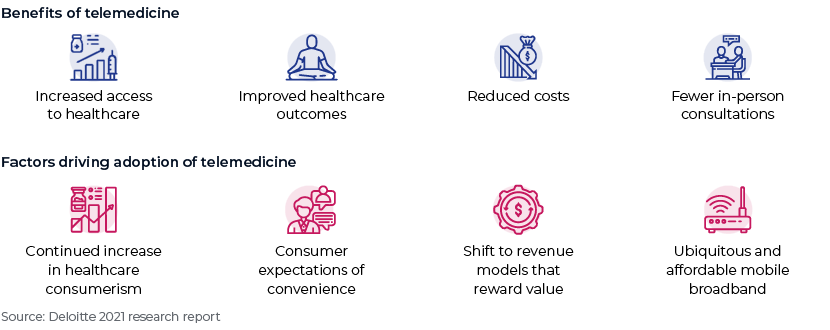
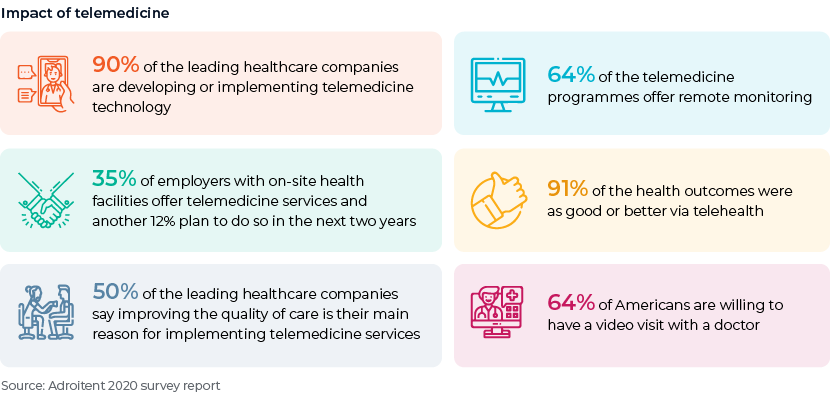
The global digital health market was valued at USD96.5bn in 2020 and is expected to grow at a CAGR of 15.1% from 2021 to 2028.
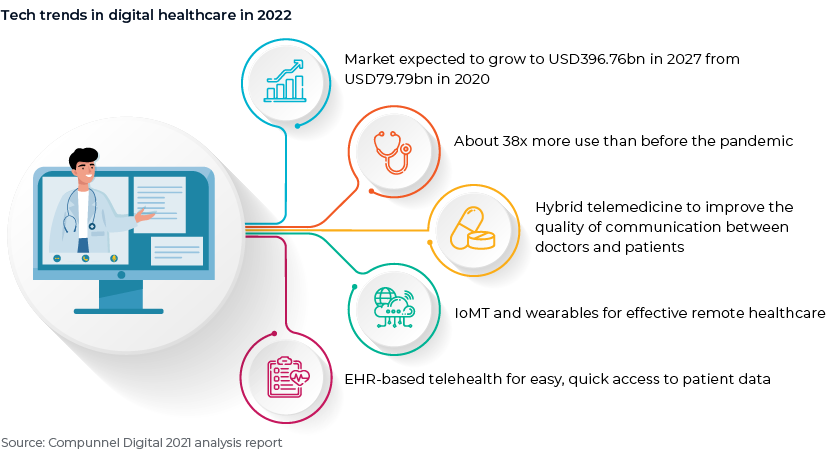
Telemedicine trends: Virtual care in Canada has grown by 240% since April 2020, with 45% of clinicians choosing to implement telemedicine services in their practice, according to McKinsey’s 2020 survey report. One in four Americans used telemedicine services amid the pandemic, and the use of telemedicine services has increased 10-fold in China since March 2020.

Key telemedicine trends:
Trend #1: Embedded EHR telehealth
Healthcare professionals providing telemedicine services use electronic health records (EHRs). With the increase in provider-to-provider telemedicine consultations (whether between provider organisations or within a single healthcare organisation), patients’ EHRs are available to all clinicians.
Advantages of EHR-based telehealth
-
Provides seamless interoperability of modules
-
Ensures data is always up to date
-
Eliminates data duplication
-
Enhances delivery of patient care
-
Facilitates scheduling and filing claims with insurance providers
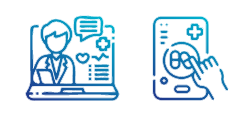
Trend #2: Telehealth internet of medical things (IoMT) and wearables
-
Medical wearables
-
Cross-platform apps
-
Real-time data exchange
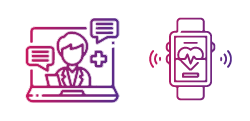
Internet of Things (IoT) solutions and wearables are two of the most prominent trends in telemedicine. Healthcare technology providers invest in software that connects patients and physicians through physical devices.
Internet of Medical Things (IoMT) tools help clinicians monitor patients at home. Modern smart beds, inhalers, ECG and EKG monitors can exchange information with telemedicine apps through an internet connection. This increases patient comfort and reduces the load on offline healthcare facilities.
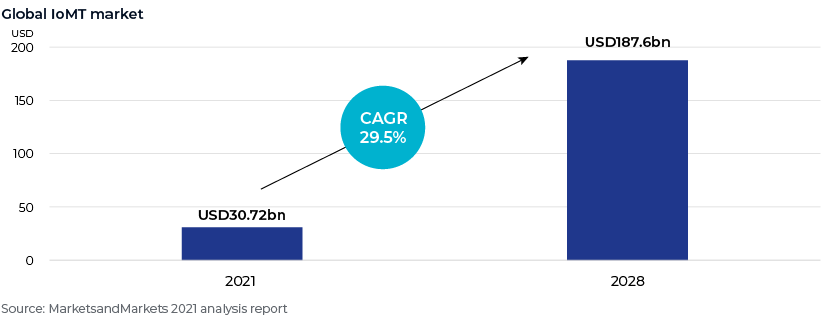
Trend #3: Big data and AI
-
Advanced data analytics
-
Machine-learning algorithms
-
Support for data-driven decision making
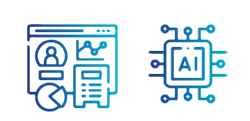
The increasing adoption of big data analytics and AI is further driving growth in the global telemedicine market. Large amounts of data can be stored in AI-based software and programs. Physicians can store not only a patient’s personal information, but also demographic and geographic data, to provide the best possible care. This technology also ensures data privacy, abiding by data protection laws. Combining big data with AI has created lucrative growth opportunities for healthcare professionals around the world.

Trend #4: Augmented reality (AR) for quality care
-
Advanced medical imaging
-
AR-aided navigation systems
-
AR education and training systems
Combining telemedicine with AR/virtual reality (VR) has brought healthcare services to another level. It enables untrained individuals to provide quality care and medical personnel to perform procedures more accurately.
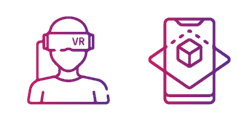
AR and VR applications include the following:
-
Displaying detailed body scans
-
Distracting patients during painful procedures
-
Increasing the accuracy of diagnoses
-
Explaining medical treatment to patients
-
Showing how the patient will react to the treatment
-
Teaching complex procedures to medical students
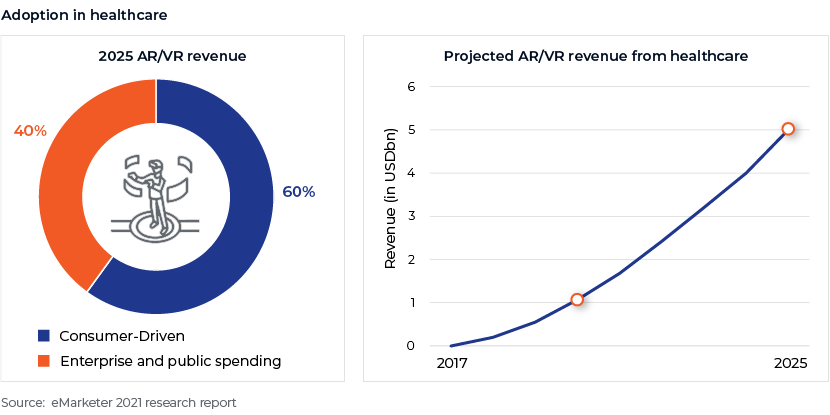
Trend #5: Data protection through cybersecurity
Virtual healthcare or telemedicine uses technology to enable patient-physician interaction, deliver care and facilitate services without the need to visit in person. As the capabilities and popularity of virtual healthcare services increase, healthcare organisations would need to continue investing in processes to ensure data security and identify and mitigate risks. The following are the five key areas to address:
-
Ensuring security of medical devices and wearables
-
Managing identity and authenticating external devices
-
Monitoring security of telemedicine services and behavioural analysis
-
Development, security and operations (DevSecOps)
-
Training in telemedicine security and creating awareness
Trend #6: Telehealth solutions with robotic process automation (RPA)
RPA drives efficiency, and the precision it offers makes it cost-effective. RPA is used widely by healthcare organisations in appointment scheduling, hospital administration and data management protocols.
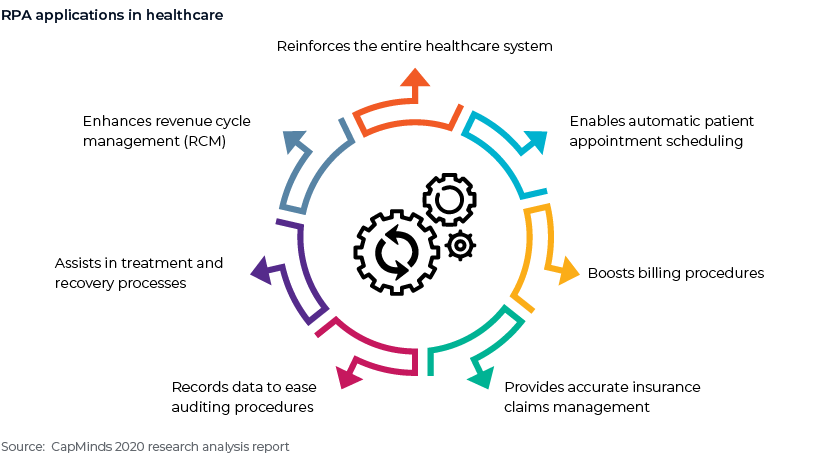

Conclusion
All areas of healthcare technology (healthtech) will likely continue to improve as the year progresses, with leading healthtech companies already adopting virtual modes of teleconsultation and AI and RPA tools to enhance work quality and productivity, and increase return on investment. Digitalisation is one of the most valuable ways in which to capitalise on the significant opportunity created by the increasing use of telehealth services. The quality and efficiency of care would continue to improve with ground-breaking and evolving technologies including cybersecurity, IoMT, machine learning and AR.
How Acuity Knowledge Partners can help
We are a leading provider of high-value research, analytics and business intelligence services to life sciences, biopharma, medtech and healthcare consulting firms.
We provide bespoke research support on market entry and due diligence, portfolio management, licensing and acquisition, go-to-market strategy, opportunity assessment, regulatory landscaping, product launch analysis, market access and therapy area assessment, indication prioritisation, market research and forecasting, pipeline analysis and benchmarking and competitive intelligence.
For more information on our capabilities, please visit our Life sciences solutions page.
Sources:
-
Ten Biggest Digital Health Trends Set to Rule in 2022 (solutionanalysts.com)
-
2022 trends: Digital Healthcare and Innovation (omnia-health.com)
-
Healthcare Technology Trends and Digital Innovations in 2022
-
Telehealth Trends to Expect in 2022 | BioFunctional Health Solutions
-
Telemedicine Trends: Eagle Telemedicine has 5 Predictions for 2021
-
Rising Trends in Digital Health: 5 Technologies That Will Define the Future of Healthcare
Tags:
What's your view?
About the Author
Shweta Gupta has ~16 years of experience in research, consulting and advisory services. She is currently part of Acuity’s strategy research and consulting team, with experience in secondary research, business, and corporate strategy, thought leadership and competitive intelligence and benchmarking.
Prior to joining Acuity Knowledge Partners, Shweta Gupta worked with companies in the consulting, telecom and research analytics domains, where she was largely responsible for strategic research, corporate strategy, landscape study, market sizing, market entry and growth strategy, operating models, business models, opportunity analysis, company and product profiling and supplier identification.
Like the way we think?
Next time we post something new, we'll send it to your inbox










